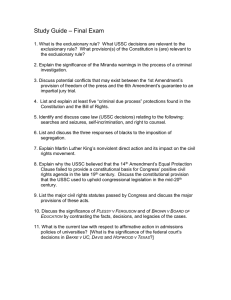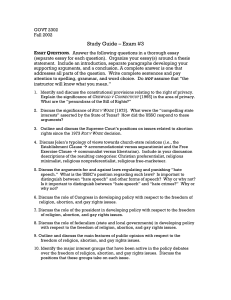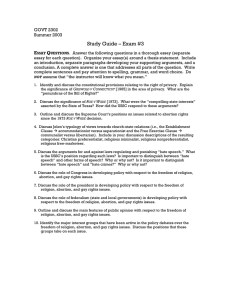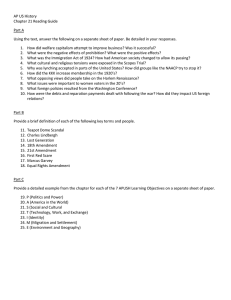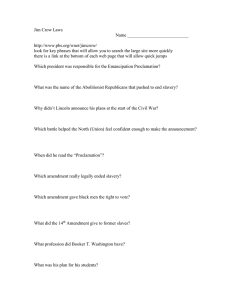Study Guide – Exam #4
advertisement
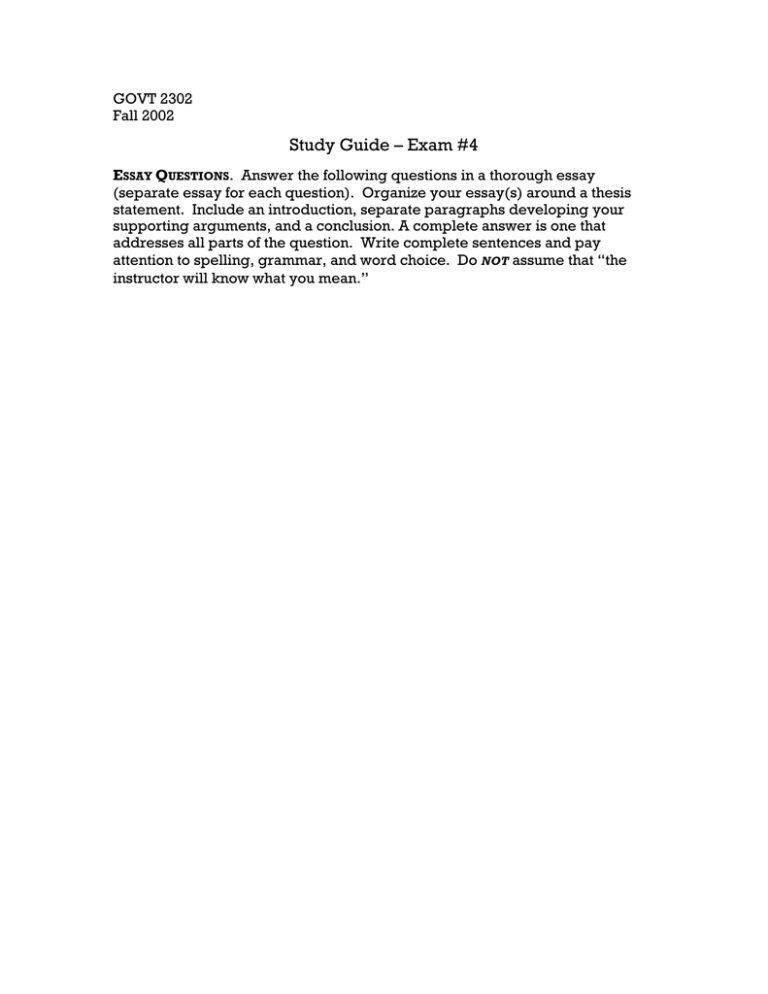
GOVT 2302 Fall 2002 Study Guide – Exam #4 ESSAY QUESTIONS. Answer the following questions in a thorough essay (separate essay for each question). Organize your essay(s) around a thesis statement. Include an introduction, separate paragraphs developing your supporting arguments, and a conclusion. A complete answer is one that addresses all parts of the question. Write complete sentences and pay attention to spelling, grammar, and word choice. Do NOT assume that “the instructor will know what you mean.” SHORT ANSWER QUESTIONS. Answer the following questions in a paragraph (a separate paragraph for each question). Do NOT answer specific parts as separate items. Integrate your responses into a well-organized, wellconstructed paragraph. A complete answer is one that addresses all parts of the question. Write complete sentences and pay attention to spelling, grammar, and word choice. Do NOT assume that “the instructor will know what you mean.” IDENTIFICATION ITEMS. Define and identify the importance of the following items. These items can generally be answered in two or three sentences. Students should go beyond simple definitions of the terms or concepts to say why each is important. It is possible that two terms may be paired in identification items. Your answer should be written to demonstrate your familiarity with and understanding of both terms or concepts in each pair. In this case, you should explain why the two are juxtaposed. Here is an example: [example] Article I, sec. 8:18 v 10th Amendment – Article I, sec 8:18 implies that the national government has powers beyond those that are expressly delegated in the Constitution while the 10th Amendment reserves for the states any powers not delegated by the Constitution to the national government. These provisions reflect the competing political philosophies of the Federalists and the Anti-Federalists respectively; consequently, the question of the balance of constitutional powers between the two levels of government must be resolved by judicial interpretation. [These columns are not necessarily intended to represent pairs of terms that might be juxtaposed on the exam.] 1. What is the exclusionary rule? What USSC decisions are relevant to the exclusionary rule? What provision(s) of the Constitution is (are) relevant to the exclusionary rule? 2. Explain the significance of the Miranda warnings in the process of a criminal investigation. 3. Discuss potential conflicts that may exist between the 1st Amendment’s provision of freedom of the press and the 6th Amendment’s guarantee to an impartial jury trial. 4. List and explain at least five “criminal due process” protections found in the Constitution and the Bill of Rights. 5. Identify and discuss case law (USSC decisions) relating to the following: searches and seizures, self-incrimination, and right to counsel. 6. List and discuss the three responses of blacks to the imposition of segregation. 7. Explain Martin Luther King’s nonviolent direct action and its impact on the civil rights movement. 8. Explain why the USSC believed that the 14 th Amendment’s Equal Protection Clause failed to provide a constitutional basis for Congress’ positive civil rights agenda in the late 19th century. Discuss the constitutional provision that the USSC used to uphold congressional legislation in the mid-20th century. 9. List the major civil rights statutes passed by Congress and discuss the major provisions of these acts. 10. Discuss the significance of PLESSY V FERGUSON and of BROWN V BOARD OF EDUCATION by contrasting the facts, decisions, and legacies of the cases. 11. What is the current law with respect to affirmative action in admissions policies of universities? [What is the significance of the federal court’s decisions in BAKKE V UC, DAVIS and HOPWOOD V TEXAS?] **SPECIAL NOTE: Be prepared to answer possible questions on the exam regarding the role of any of the institutions discussed in the photocopied articles with respect to the abortion, gay rights, pornography, death penalty, and affirmative action issues. For example, Discuss the role of Congress (alternatively president, bureaucracies, courts, public opinion, interest groups, or federalism) in developing policy with respect to the abortion, gay rights, pornography, death penalty, and affirmative action issues. 6. Discuss the role of Congress in developing policy with respect to the freedom of religion, abortion, and gay rights issues. 7. Discuss the role of the president in developing policy with respect to the freedom of religion, abortion, and gay rights issues. 8. Discuss the role of federalism (state and local governments) in developing policy with respect to the freedom of religion, abortion, and gay rights issues. 9. Outline and discuss the main features of public opinion with respect to the freedom of religion, abortion, and gay rights issues. 10. Identify the major interest groups that have been active in the policy debates over the freedom of religion, abortion, and gay rights issues. Discuss the positions that these groups take on each issue. 16. What is the exclusionary rule? What USSC decisions are relevant to the exclusionary rule? What provision(s) of the Constitution is (are) relevant to the exclusionary rule? 17. What are the Miranda warnings? Explain their significance in the process of a criminal investigation. 18. What potential conflict exists between the 1st Amendment’s provision of freedom of the press and the 6th Amendment’s guarantee to an impartial jury trial? Discuss. 19. List and explain at least five “criminal due process” protections found in the Constitution and the Bill of Rights. 20. Identify and discuss case law (USSC decisions) relating to the following: searches and seizures, self-incrimination, and right to counsel. 21. List and discuss the three responses of blacks to the imposition of segregation. 22. Explain Martin Luther King’s nonviolent direct action and its impact on the civil rights movement. 23. Explain why the USSC believed that the 14th Amendment’s Equal Protection Clause failed to provide a constitutional basis for Congress’ positive civil rights agenda in the late 19th century. Discuss the constitutional provision that the USSC used to uphold congressional legislation in the mid-20th century. 24. List the major civil rights statutes passed by Congress and discuss the major provisions of these acts. 25. Discuss the significance of PLESSY V FERGUSON and of BROWN V BOARD OF EDUCATION by contrasting the facts, decisions, and legacies of the cases. 26. What is the current law with respect to affirmative action in admissions policies of universities? [What is the significance of the federal court’s decisions in BAKKE V UC, DAVIS and HOPWOOD V TEXAS?] 27. Identify the following: 12. Identify the following: Emancipation Proclamation Jim Crowism equality of opportunity equality of results de jure segregation de facto segregation affirmative action set-aside program reverse discrimination comparable worth glass ceiling 14th Amendment 18th Amendment 19th Amendment DRED SCOTT V SANFORD CIVIL RIGHTS CASES of 1883 PLESSY V FERGUSON BROWN V BOARD OF EDUCATION SWANN V CHARLOTTE-MECHLENBURG BAKKE V UC, DAVIS HOPWOOD V TEXAS Emancipation Proclamation Jim Crowism equality of opportunity equality of results de jure segregation de facto segregation affirmative action set-aside program reverse discrimination comparable worth glass ceiling 14th Amendment 18th Amendment 19th Amendment DRED SCOTT V SANFORD CIVIL RIGHTS CASES of 1883 PLESSY V FERGUSON BROWN V BOARD OF EDUCATION SWANN V CHARLOTTE-MECHLENBURG BAKKE V UC, DAVIS HOPWOOD V TEXAS
